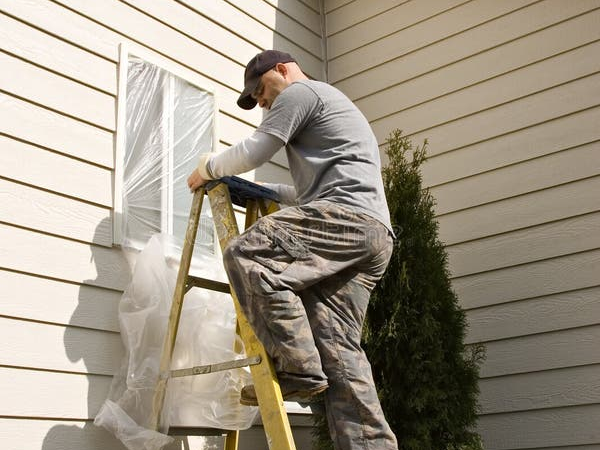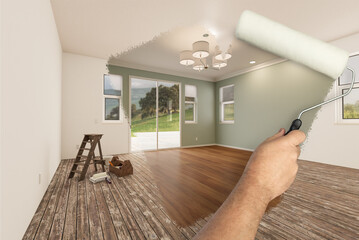How to Go About Exterior Painting
Repainting your home’s exterior is a great way to add value. West Chester Painters protects your property from rain and sun. It blurs the line between indoors and outdoors and is a relatively low-cost, painless DIY project.

Paints are formulated with various ingredients, including pigments for color, binders to hold the pigments in place, and solvents that allow it to spread easily. The quality of your painting job depends on the temperature and weather conditions at the time of application.
There is a lot to think about when it comes time to choose exterior paint. There are zillions of colors from which to choose, different finishes and product lines with various quality-based tiers, all the tools and brushes that go with them, and the debate of whether to use oil or water-based paint.
Oil-based paint is a mixture of resin, thinner and pigment. The pigment gives the color, the thinner evaporates, and the remaining resin forms a hard, durable coating that is resistant to scratches and scuffing. Because of this, it is a great choice for high-traffic areas, such as doors and windows.
The main issue with this type of paint is its volatile organic compounds (VOCs), which emit a strong and unpleasant odor while drying, as well as being harmful to the environment once they have evaporated into the air. This is why it is recommended to wear a mask while painting with it and work in a well-ventilated area.
VOCs are released when the organic solvent in the paint dries, and they have been known to cause a wide range of health issues, including headaches, nausea and respiratory problems. They are also a contributing factor to smog, which is why it is important that you dispose of any paint with high VOC levels properly.
It is also worth noting that while VOCs are harmful to humans, they are even more detrimental to the environment. When VOC-heavy paint is not disposed of properly, it can make its way into groundwater and into drinking water supplies. From there, it can move through soil and rise into buildings, affecting airflow and potentially causing a number of other issues.
While this is not a good reason to avoid painting with oil-based paints, it is an important consideration when choosing a type of exterior paint for your home. Water-based paints are much more environmentally friendly than their oil-based counterparts. Additionally, they tend to dry faster and be more tolerant of weather conditions such as humidity and temperature changes. This makes them a better choice for most projects, especially in harsh climates.
Many modern homeowners prefer water-based paint for their homes. This type of paint does not contain any oil and therefore emits much less volatile organic compounds (VOC) during application. This makes it much safer for painters and home owners to work with as it does not give off strong fumes that can cause headaches, difficulty breathing and an overwhelming odour that is disturbing to children. This type of paint also performs well for exterior painting as it is much more resistant to UV rays and is able to expand and contract with changing weather conditions.
Unlike the oil based paint that was used in the past, modern paints are now made from a combination of pigments, binders and a percentage of water. They are known as latex or acrylic paints and they can be very effective in protecting your exterior surfaces from moisture, mould and mildew, stains and other damage.
The key to choosing the right paint is to select one that has high quality pigments in it. This ensures that the paint covers completely and in a single coat, which can save you thousands of dollars over the long term because low-quality exterior paint will require more than one coat and will not last as long.
Another factor to consider is the drying time of the paint. While many water based paints are touch dry within an hour and ready for a second coat in three hours, oil-based paints can take up to an entire day before they are ready.
If you are unsure about what type of paint to choose for your project, ask your local professional painting company. They can provide advice based on your specific needs and the type of materials in your home. They can also recommend a suitable primer that will help the new paint adhere to the surface of your house and create an effective barrier against the elements. This will ensure that your paint job looks great and lasts for years to come. You can check whether a paint is water based or not by applying methylated spirits to a rag and wiping a small section of your wall. If the rag is stained with the paint colour, then it is water based and vice versa.
Acrylic paint is a water-based paint used by artists to create colorful works of art. It is non-toxic, inexpensive and easily cleaned up with soap and water. It is also durable and can withstand many outdoor conditions. Unlike oil paint, acrylic can be applied thickly or thinly, allowing you to achieve the desired effect.
The key to a successful application of acrylic paint is proper surface preparation. Using a gesso primer will help your work to adhere to the surface and prevent it from lifting. Using a good quality brush and keeping it clean will also make your painting process much easier. You may also want to consider adding an acrylic retarder to your paint, which will slow the evaporation of water from the paint film. This will give you more time to blend your colors and apply glazes.
Like most paints, acrylic has a number of ingredients that are necessary to create the final product. Solvents are quick-evaporating liquids that keep the binders and pigments in suspension. Pigments are powdered minerals or man-made colors that give the paint its hue and opacity. Binders are resins that coalesce to form the paint film after the solvents evaporate.
Although acrylic can be used on a variety of surfaces, it’s important to do your research and find the best paint for your project. For instance, acrylic doesn’t adhere well to some types of metals and glass. It’s also not as durable as latex paint.
Acrylic can be used for exterior residential painting, but it’s most often chosen by artists to create murals. It’s great on a number of different materials and is flexible enough to accommodate varying temperatures. It’s also breathable, allowing moisture to escape.
Acrylic paint can be finished with a clear varnish. It’s best to choose a varnish that’s specifically made for acrylic paint. Using a regular varnish can cause the paint to crack and peel. It’s also important to wait a few days, or ideally a few weeks, before applying the varnish so that the paint is fully dry.
If you’re painting a new or fresh-looking wall in a different color, then you should definitely use a primer and sealer to prepare the surface. This will help the paint last longer and look better overall. But if you’re repainting an existing surface that doesn’t have any signs of peeling or stains, you may not need to use primer at all.
The main purpose of a primer is to cover the underlying dark or light color that is already present on the surface being painted. This will ensure that the overcoat paints will produce an even and smooth resulting color. Primers also help to hide minor imperfections and blemishes in the surface being painted. A good quality primer should be thick, providing a “tooth” for the overcoat paints to adhere to the surface.
When choosing a primer, it’s important to select one that is specifically formulated for the type of surface you’re going to be painting. There are multiple types of primers available including oil, shellac and latex, each containing different types of binders. These binders provide adhesion and other properties that are specific to the surface.
There are also stain-blocking primers that are heavily tinted to prevent mildew and other stains from bleeding through the topcoat of paint. These are particularly recommended for surfaces that receive a lot of sun exposure.
Finally, there are bonding primers that are designed to stick to glossy surfaces and are usually a latex product. These are ideal for shiny surfaces such as glass, plastic and glazed tile.
Another option is to purchase a 3-in-1 primer/sealer/undercoat, which is typically an oil-based product. These are designed to save time and money on the job by eliminating the need to buy separate products. However, these products should only be used on surfaces that don’t require too much additional prep work to be ready for paint.
If you’re unsure of which type of product to use, consult with an experienced professional. They will be able to provide you with the best information and products for your project. A little bit of research will go a long way in making your painting project a success.



